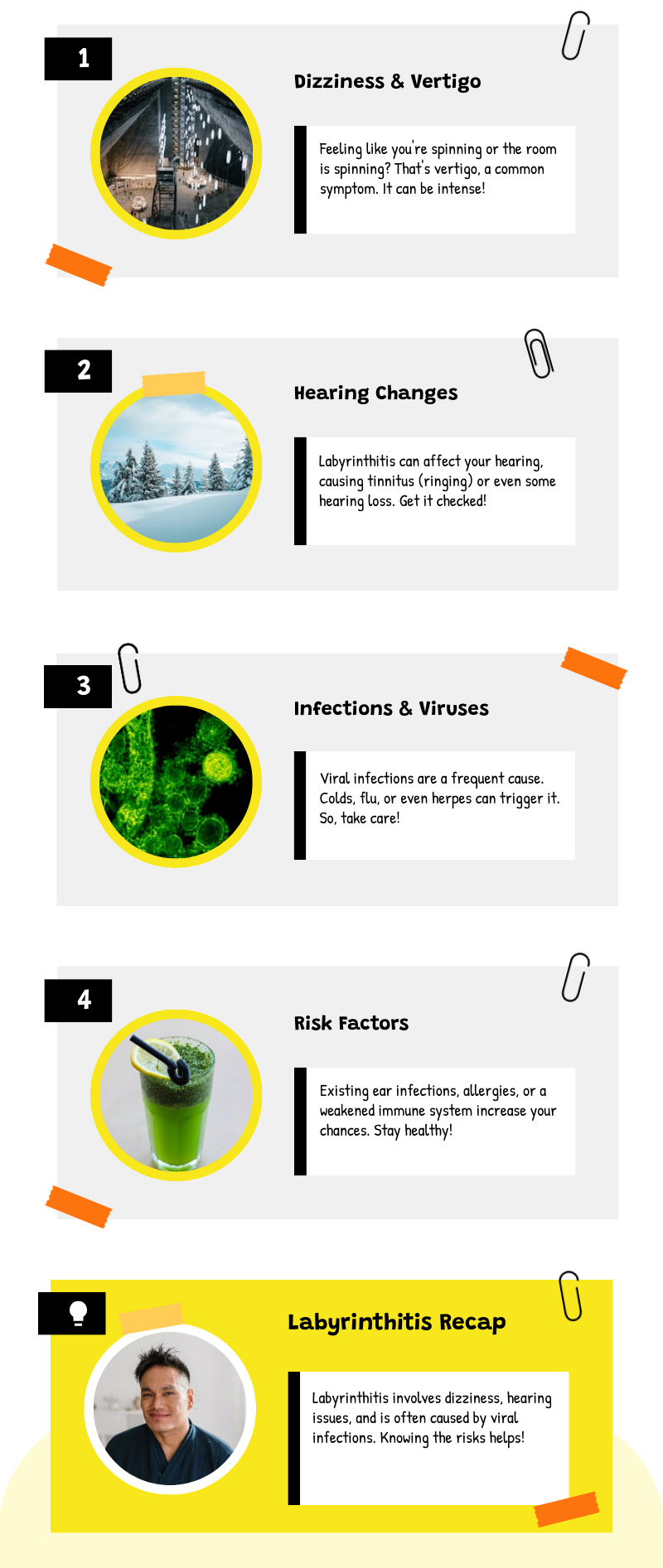
Head of Online Medical Content

Audiology Expert

What is Labyrinthitis?
Discover the symptoms, risk factors, causes, treatments, and prognosis
Overview | Why quick medical attention is key | Symptoms and causes | Complications and diagnosis | Treatment and prevention | When to seek help | Summary
Last Hearing Aid UK Update:
Overview
Labyrinthitis is an inner ear inflammation that affects balance and hearing, often caused by viral infections. Symptoms include dizziness, vertigo, nausea, and hearing loss. Risk factors include stress, infections, and certain medications.
Early treatment is vital to avoid long-term issues. Most people recover within six weeks with medication, rest, and therapy.
Prompt medical attention is key to successful treatment
A condition that is generally not dangerous, labyrinthitis is an inflammation of the labyrinth, a part of your inner ear. As this area is responsible for balance and hearing, it causes unpleasant symptoms such as vertigo.
If ignored, labyrinthitis can result in long-term balance problems and permanent hearing loss.
Commonly affecting adults aged between 30-60, it is closely linked to vestibular neuritis. When comparing the two, labyrinthitis is a swelling of both the vestibulocochlear nerve, ultimately leading to both balance and hearing complications.
Whereas vestibular neuritis results in one branch being inflamed, leading to balance issues only.
Due to the nature of the condition and the risks of future hearing and balance health problems, prompt treatment is key. But what do we know about labyrinthitis, and what should your next steps be if you suspect you have it?
Symptoms, causes, and risk factors
The known risk factors of labyrinthitis are certain medications (antidepressants, anti-inflammatories, and drugs that treat diabetes), excessive alcohol consumption, flu, smoking, allergies, fatigue, and stress.
If you have labyrinthitis, your symptoms are usually sudden and may include:
- Balance issues
- Blurred vision
- Struggling to concentrate
- Dizziness
- Hearing loss
- Nausea and vomiting
- Nystagmus (sporadic eye movements)
- Tinnitus (ringing in your ears)
- Vertigo
The causes of labyrinthitis are usually viral infections; however, bacterial infections can also be the cause. Here are some common examples: Epstein-Barr virus, Herpes simplex, stomach flu, upper respiratory infection, and head injury (a very rare cause).
Related reading: Types of hearing loss

Complications and diagnosis
Labyrinthitis only gets more complicated if it is left untreated, as without the right medical attention, it can result in hearing loss, dangerous falls, and permanent damage to your inner ear.
Diagnosing labyrinthitis is performed by your local GP, who will examine you and go through your medical history. There are various tests they may do to confirm the condition as well as assess your balance, hearing, and how well your nervous system is functioning.
They will generally want to rule out other underlying health conditions, like vestibular neuritis, with tests such as:
- Electrocardiogram (EKG)
- Magnetic resonance imaging (MRI)
- Vestibular testing
Treatment, prognosis and prevention
The treatment for labyrinthitis ultimately depends on how severe your condition is. Your GP might recommend at-home remedies, physical therapy, medication or a combination of them all. Only the very complex cases need surgery, and such cases are extremely rare.
When we look at the available medications that can be prescribed for labyrinthitis, your GP might offer antivirals, antibiotics, corticosteroids (which reduce nerve inflammation), and drugs to manage nausea and dizziness (often diphenhydramine or fexofenadine).
Gentle exercises at home can help manage dizziness and imbalance if your symptoms are still ongoing after a few weeks. This is called vestibular rehabilitation therapy.
Many also try some home remedies to ease the debilitating symptoms that are common with labyrinthitis. These might include:
- Gargling warm salty water to help clear any blockage in your eustachian tube (connects your throat to your middle ear)
- Applying a warm compress over your ear
- Reducing alcohol intake
- Meditation and mindfulness to reduce stress
How quickly people respond to treatment again varies depending on the severity, and also, what works for one person might not necessarily work for others.
As a rule of thumb, labyrinthitis usually lasts for around six weeks; however, most people do start to feel improvements around two weeks.
As labyrinthitis is often a result of other health conditions, the best preventative advice would be to wash your hands regularly, especially during the colder months when there is a higher risk of developing a cold and flu.
When to seek medical help
If you experience vertigo, nausea, or balance problems, contact your healthcare provider immediately. They can help identify the cause of your symptoms and create a tailored treatment plan. Questions you could ask your GP if you are diagnosed with labyrinthitis:
- How can I relieve my symptoms?
- What tests do I need to undergo?
- Are there medications I can take?
- Is hearing loss a potential outcome?
- What treatment options are available to me?
Summary
Labyrinthitis is a non-life-threatening condition that causes sudden symptoms like dizziness, hearing loss, and balance problems due to inner ear inflammation. It’s often triggered by viral infections and influenced by factors such as stress, fatigue, and certain medications.
Early diagnosis and treatment are important to prevent complications. Most people recover fully within a few weeks through a combination of medication, rest, and physical therapy.
Why Choose Us?
- FREE Hearing Tests
- Best Hearing Aids and Prices
- FREE Aftercare for Life
- FREE Home Visits
- 200+ Local Audiologists
- 60 Day Money Back Guarantee
Think you might be suffering from labyrinthitis?
Labyrinthitis usually isn’t serious. But it can cause debilitating side effects. The resulting vertigo can make it hard for you to get out of bed and go about your daily life. Should you develop symptoms, don’t wait until they get worse.
Timely treatment can reduce the likelihood of long-term inner ear issues. However, if you have hearing loss due to prolonged labyrinthitis or another condition, we can help support you locally.
We offer free hearing assessments in a clinic in your area or in your very home at no extra cost.
Other hearing loss awareness articles you might like...
 What is Swollen Ear?
What is Swollen Ear?  Accepting Hearing Loss
Accepting Hearing Loss  Tips for hearing in restaurants
Tips for hearing in restaurants Our specialist service includes:
Do not spend hundreds of pounds without getting a second opinion from us.
Please call us on 0800 567 7621
 Not only are the prices great, but the service is fantastic! Many thanks to your team.
Not only are the prices great, but the service is fantastic! Many thanks to your team.What's included in our hearing aid prices?
Watch Bupa's video on how labyrinthitis develops below
Other pages you might find useful
Common FAQs about hearing aids and hearing loss
In general, any audiologist will always recommend to you the hearing aid model that best suits your needs. Here is a useful checklist to make sure that is the case.
- Audiologist's level of knowledge: The audiologist you have seen will hopefully have a wide knowledge of all available hearing aids; however, some will only be familiar with a small number of brands and, therefore, may not really be in a position to know which model is the best for you. It is OK to challenge their recommendation and ask them to justify why this particular brand is the one for you.
- Do research: Read about the hearing aid that was recommended. Does it seem like it will suit your lifestyle? Does it have more or fewer features than you need?
- Be aware of sales targets: Many high street retailers have specific tie-ins to a particular manufacturer/brand. The hearing aid they have suggested may still be the correct one for you, but do your research so that you know why they might have recommended it.
If you have significant hearing loss in both ears, you should be wearing two hearing aids. Here are the audiological reasons why:
Localisation: The brain decodes information from both ears and compares and contrasts them. By analysing the minuscule time delays as well as the difference in the loudness of each sound reaching the ears, the person is able to accurately locate a sound source.
Simply put, if you have better hearing on one side than the other, you can't accurately tell what direction sounds are coming from.
Less amplification is required: A phenomenon known as “binaural summation” means that the hearing aids can be set at a lower and more natural volume setting than if you wore only one hearing aid.
Head shadow effect: High frequencies, the part of your hearing that gives clarity and meaning to speech sounds, cannot bend around your head. Only low frequencies can. Therefore, if someone is talking on your unaided side, you are likely to hear that they are speaking, but be unable to tell what they have said.
Noise reduction: The brain has its own built-in noise reduction, which is only really effective when it is receiving information from both ears. If only one ear is aided, even with the best hearing aid in the world, it will be difficult for you to hear in background noise as your brain is trying to retain all of the sounds (including background noise) rather than filtering them out.
Sound quality: We are designed to hear in stereo. Only hearing from one side sounds a lot less natural to us.
Fancy some further reading on this topic? You can read about why two hearing aids are better than one in our article, hearing aids for Both Ears, here
For most people, the main benefit of a rechargeable hearing aid is simple convenience. We are used to plugging in our phones and other devices overnight for them to charge up. Here are some other pros and cons:
For anybody with poor dexterity or issues with their fingers, having a rechargeable aid makes a huge difference, as normal hearing aid batteries are quite small and some people find them fiddly to change.
One downside is that if you forget to charge your hearing aid, then it is a problem that can't be instantly fixed. For most, a 30-minute charge will get you at least two or three hours of hearing, but if you are the type of person who is likely to forget to plug them in regularly, then you're probably better off with standard batteries.
Rechargeable aids are also a little bit bigger and are only available in Behind-the-Ear models.
Finally, just like with a mobile phone, the amount of charge you get on day one is not going to be the same as you get a few years down the line. Be sure to ask what the policy is with the manufacturer's warranty when it comes to replacing the battery.
For most people, the answer is yes. But it's never that simple.
The majority of hearing problems affect the high frequencies a lot more than the low ones. Therefore, open fitting hearing aids sound a lot more natural and ones that block your ears up can make your own voice sound like you are talking with your head in a bucket. Therefore, in-ear aids tend to be less natural.
However, the true answer is we can't tell until we have had a look in your ears to assess the size of your ear canal, and until we have tested your hearing to see which frequencies are being affected.
People with wider ear canals tend to have more flexibility, also there are open fitting modular CIC hearing aids now that do not block your ears.
There is also the age-old rule to consider, that a hearing aid will not help you if it's sat in the drawer gathering dust. If the only hearing aid you would be happy wearing is one that people can't see, then that's what you should get.
Most people can adapt to any type of hearing aid, as long as they know what to expect. Have an honest conversation with your audiologist as to what your needs are.
Generally speaking, six or more. Unless it's none at all. The number of channels a hearing aid has is often a simplistic way an audiologist will use to explain why one hearing aid is better than another, but channels are complex, and it is really not that straightforward. Here are some reasons why:
Hearing aids amplify sounds of different frequencies by different amounts. Most people have lost more high frequencies than low, and therefore need more amplification in the high frequencies. The range of sounds you hear is split into frequency bands or channels, and the hearing aids are set to provide the right amount of hearing at each frequency level.
Less than six channels, and this cannot be done with much accuracy, so six is the magic number. However, a six-channel aid is typically very basic with few other features and is suitable only for hearing a single speaker in a quiet room. The number of channels is not what you should be looking at; it's more the rest of the technology that comes with them.
As a final note, different manufacturers have different approaches. One method is not necessarily better than any other. For example, some manufacturers have as many as 64 channels in their top aids. Most tend to have between 17 and 20. One manufacturer has no channels at all.
Manufacturer's warranties typically last between 2-5 years, depending on the brand and model, and cover defects in materials and workmanship. This includes repairs for component failures, electronic malfunctions, and manufacturing defects, but excludes damage from misuse, accidents, or normal wear. Most manufacturers also include loss and damage insurance for the first year.
We handle all warranty claims on your behalf, liaising with manufacturers and ensuring you get replacement devices quickly when needed. This comprehensive warranty coverage, combined with our lifetime aftercare, gives you complete peace of mind.
Our hearing tests are completely free, whether at our clinics or in your home. Unlike other providers who charge £30-£100 for home visits, we believe hearing healthcare should be accessible without financial barriers. Our comprehensive assessments include examination by a registered audiologist, audiogram results, and personalised recommendations.
All testing, future adjustments, and ongoing support are included at no extra cost. While NHS tests are also free, typical 6-week waiting periods often lead people to seek immediate private testing. We provide prompt, professional assessments that fit your schedule and budget.
Yes, we offer completely free home visits throughout the UK, and this service is included in our prices with no additional charges. Home visits are particularly valuable for people with mobility issues, busy schedules, or those who simply prefer the comfort and convenience of their own environment.
Our audiologists can conduct full hearing tests, fit hearing aids, and provide ongoing support in your home. This service sets us apart from many providers who either don't offer home visits or charge extra for them.
We can offer prices up to 40% lower than high street retailers because of our business model. As a network of 200+ independent audiologists, we don't have the massive overheads of large retail chains - no expensive high street premises, no sales targets pushing audiologists to sell the most expensive options, and no costly marketing campaigns.
However, we maintain the same buying power as the big chains because we purchase on behalf of our entire nationwide network. This means you get access to the same premium hearing aids with professional service, but at genuinely competitive prices.
We offer a comprehensive 60-day money-back guarantee, which gives you twice the industry standard time to properly assess whether your hearing aids are right for you. This extended period recognises that adjusting to hearing aids takes time, and your brain needs several weeks to adapt to the amplified sounds.
Unlike many providers who offer just 30 days, we believe 60 days gives you the confidence to test your hearing aids in all the situations that matter to you - from quiet conversations at home to busy restaurants and outdoor activities.
Ask the Experts
6 Morton Lane
Walkwood
Redditch
Worcestershire
B97 5QA
Latest Launch
When we refer to a product as 'Latest Launch', we mean it is the latest to be released on the market.
New
When we refer to a product as 'New', we mean that the product is the newest hearing aid model on the market.
When we refer to a product as 'Superseded', we mean that there is a newer range available which replaces and improves on this product.
Older Model
When we refer to a product as an 'Older Model', we mean that it is has been superseded by at least two more recent hearing aid ranges.
